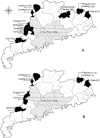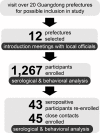Serologic and behavioral risk survey of workers with wildlife contact in China
- PMID: 29614074
- PMCID: PMC5882129
- DOI: 10.1371/journal.pone.0194647
Serologic and behavioral risk survey of workers with wildlife contact in China
Erratum in
-
Correction: Serologic and behavioral risk survey of workers with wildlife contact in China.PLoS One. 2018 Apr 30;13(4):e0196701. doi: 10.1371/journal.pone.0196701. eCollection 2018. PLoS One. 2018. PMID: 29709014 Free PMC article.
Abstract
We report on a study conducted in Guangdong Province, China, to characterize behaviors and perceptions associated with transmission of pathogens with pandemic potential in highly exposed human populations at the animal-human interface. A risk factor/exposure survey was administered to individuals with high levels of exposure to wildlife. Serological testing was performed to evaluate prior infection with several wildlife viral pathogens. Follow up serology was performed on a subset of the cohort as well as close contacts of individuals. 1,312 individuals were enrolled in the study. Contact with a wide range of wildlife species was reported in both occupational and occasional contexts. The overall proportion of individuals seropositive to any of the tested wildlife pathogens was approximately 4.0%. However, persons employed as butchers demonstrated a seropositivity of 9.0% to at least one pathogen of interest. By contrast, individuals working as hunters had lower rates of seropositivity. Among the study population, a number of other behaviors showed correlation with seropositivity, including contact with particular wildlife species such as field rats. These results demonstrate the need to further explore zoonotic risks of particular activities regarding wildlife contact, and to better understand risks of persons working as butchers with wildlife species.
Conflict of interest statement
Figures


References
-
- Jones KE, Patel NG, Levy MA, Storeygard A, Balk D, Gittleman JL, et al. Global trends in emerging infectious diseases. Nature. 2008;451(7181):990–3. doi: 10.1038/nature06536 . - DOI - PMC - PubMed
-
- Wolfe ND, Daszak P, Kilpatrick AM, Burke DS. Bushmeat Hunting, Deforestation, and Prediction of Zoonotic Disease. Emerging Infectious Diseases. 2005;11(12):1822–7. doi: 10.3201/eid1112.040789 - DOI - PMC - PubMed
-
- Webster RG. Wet markets—a continuing source of severe acute respiratory syndrome and influenza? The Lancet. 2004;363(9404):234–6. doi: 10.1016/s0140-6736(03)15329-9 - DOI - PMC - PubMed
-
- Fevre EM, Bronsvoort BM, Hamilton KA, Cleaveland S. Animal movements and the spread of infectious diseases. Trends Microbiol. 2006;14(3):125–31. doi: 10.1016/j.tim.2006.01.004 . - DOI - PMC - PubMed
Publication types
LinkOut - more resources
Full Text Sources
Other Literature Sources

